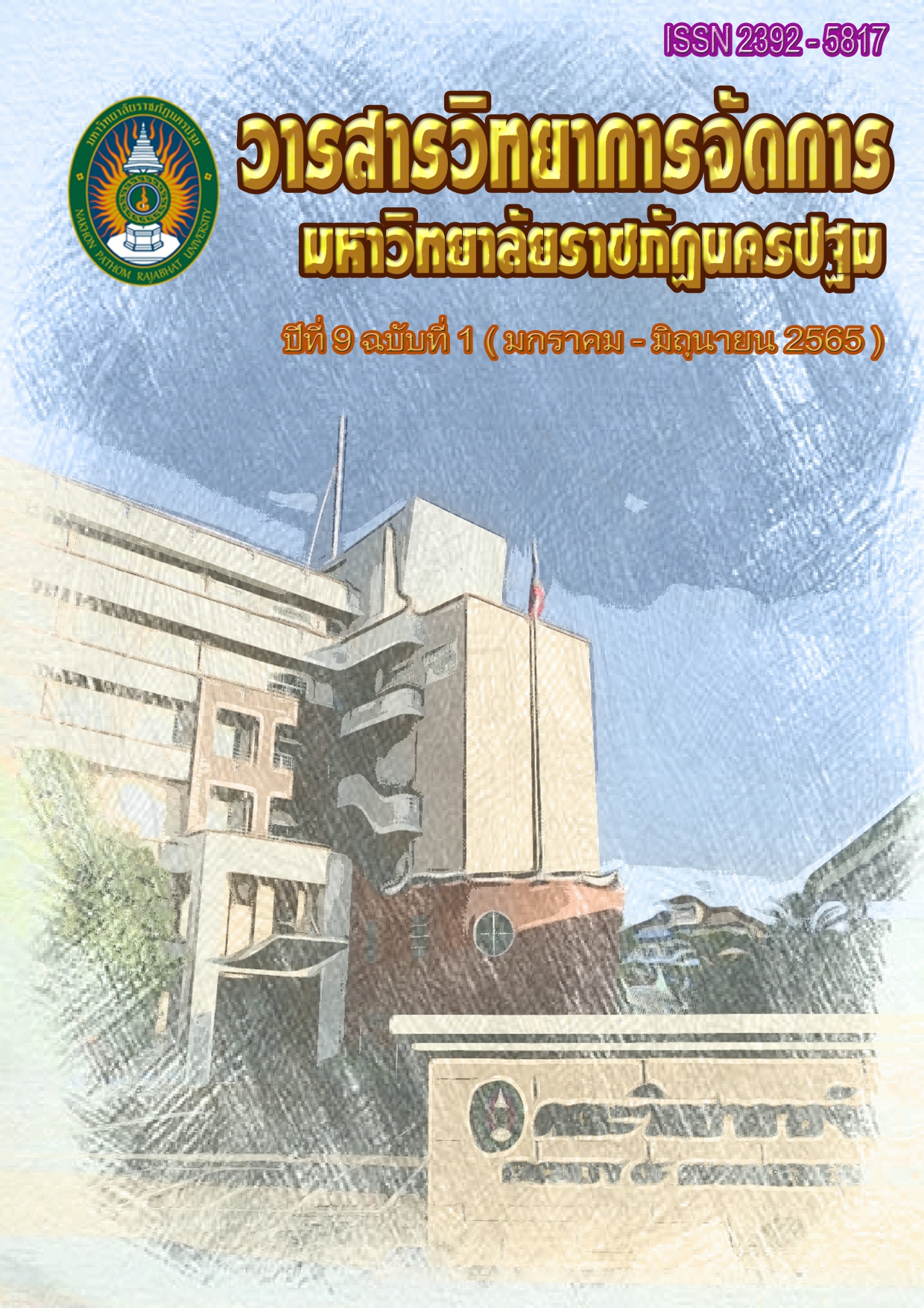Guidelines for the development of SMART competency in operations of personnel in the 5th Air Force Wing
Main Article Content
Abstract
This research aimed to study: (1) level of SMART competency in the operation of Personnel in Air Division 5, Royal Thai Air Force (2) application of THAILAND 4.0 in the operation, influence on SMART performance in the operation of the personnel in Air Division 5, Royal Thai Air Force. The job of the personnel in the 5th Air Force's Royal Air Force. Quantitative research consisted of 130 military personnel working in the Air Force 5 Wing Air Force using stratified random sampling, using questionnaires as a research tool. Data were treated and analyzed by using descriptive and Inferential Statistics methods, which were percentage, mean, standard deviation and Multiple Regression Analysis. The qualitative research, use in depth interviews from key informants, including supervisors working in Air Division 5 from the Air Force Division. Direct units, Wing 5, Technical Division, Wing 5 and Operations Wing 5, a total of 4 persons.
Findings:
1. SMART competency level in the performance of personnel in the Air Force Division 5 in the Air Force as a whole and in each area There is a high level of performance. In the following order In terms of thinking, working as a team, focusing on achievement Moral side In maintaining accuracy and liability And the sacrifice
2. Application of Thailand 4.0 in the operation Technology Integration Influence the development of SMART capability of the Air Force in the 5th Air Force with a statistic significance of 0.001 in creativity. Influence the SMART performance development of the personnel in the Air Force Division 5 in the Royal Thai Air Force with statistical significance of 0.01, and innovation has a significant influence on the development of the SMART capability of the Air Force in Division 5, Royal Air Force with statistical significance at 0.05
3. Guidelines for developing SMART competencies in the performance of personnel in the Air Force 5 Squadron found that (1) SMART competencies in personnel performance There is a promotion and support for the personnel of the Air Force 5 Air Force to create sacrifice consciousness and cultivate morality. The work plan and indicators of the work performed to achieve the goals are clearly defined. (2) The application of THAILAND 4.0 in the work shows that there is improvement and development of work to achieve a clearer result. Develop themselves to keep pace with modern technology, speakers, and adapt themselves to keep up with the globalization era. In order to maximize the benefits of the agency.
Article history : Received 4 August 2020
Revised 19 December 2020
Accepted 24 December 2020
SIMILARITY INDEX = 0.90 %.
Article Details

This work is licensed under a Creative Commons Attribution-NonCommercial-NoDerivatives 4.0 International License.
The views and opinions of the article appearing in this journal are those of the author. It is not considered a view and responsibility of the editorial staff.
References
กรมกำลังพลทหาร กองบัญชาการกองทัพไทย. (2559). ระเบียบ บก.ทท. ว่าด้วยการประเมินผลการปฏิบัติราชการ กำลังพลของ บก.ทท.พ.ศ. 2559. [ออนไลน์]. สืบค้นเมื่อ 14 เมษายน 2563 จาก https://j1.rtarf.mi.th.
ชลธิชา ชิวปรีชา. (2554). ความคิดสร้างสรรค์ของเด็กปฐมวัยที่ทำกิจกรรมศิลปะด้วยใบตอง. ปริญญานิพนธ์การศึกษามหาบัณฑิต มหาวิทยาลัยศรีนครินทรวิโรฒ.
ดิสพงศ์ จันทร์นิล. (2561). การพัฒนาสมรรถนะการปฏิบัติงานของข้าราชการทหาร สังกัดกองพันทหารราบที่ 2 กรมทหารราบที่ 1 กองพลนาวิกโยธิน หน่วยบัญชาการนาวิกโยธิน. วิทยานิพนธ์รัฐประศาสนศาสตรมหาบัณฑิต มหาวิทยาลัยนานาชาติแสตมฟอร์ด.
ธวัชชัย ผลสะอาด. (2559). กำลังพลสำรองกองร้อยที่ 1 กองพันทหารราบที่ 2 รักษาพระองค์ ค่ายพรหมโยธิน อำเภอเมือง จังหวัดปราจีนบุรี : กรณีศึกษาเปรียบเทียบระบบการเกณฑ์ทหารและการรับราชการทหารโดยสมัครใจ. การค้นคว้าอิสระรัฐศาสตรมหาบัณฑิต มหาวิทยาลัยธรรมศาสตร์.
พรศรี ลีลาพัฒนวงศ์. (2562). ปัจจัยที่มีอิทธิพลต่อการยอมรับนวัตกรรมและเทคโนโลยี : กรณีศึกษายานยนต์ไฟฟ้าประเภทยานยนต์นั่งส่วนบุคคลไม่เกิน 7 คน (รย.1). วารสารวิจัยและพัฒนา มจธ, 42 (2), 129-144.
ภัทรกันย์ สุขพอดี. (2556). การพัฒนาสมรรถนะหลักของกำลังพลสังกัดกรมกำลังพลทหารบกกองทัพบกเพื่อรองรับการเข้าสู่ประชาคมอาเซียนในปี 2558. ภาคนิพนธ์รัฐศาสตรมหาบัณฑิต มหาวิทยาลัยธรรมศาสตร์.
ภาณุมาศ เวหาด. (2559). สมรรถนะหลักกับประสิทธิผลในการปฏิบัติงานด้านงานข่าวของข้าราชการทหาร สังกัด กอง 6 ศูนย์รักษาความปลอดภัย กองบัญชาการกองทัพไทย. สารนิพนธ์หลักสูตรปริญญารัฐประศาสนศาสตรมหาบัณฑิต มหาวิทยาลัยเกริก.
มุจลินทร์ ผลกล้า. (2558). KmFl Model เพื่อการพัฒนาสมรรถนะการจัดการความรู้และสมรรถนะนวัตกรรมของสำนักวิทยบริการและเทคโนโลยีสารสนเทศ มหาวิทยาลัยราชภัฏ. วารสารวิทยบริการ มหาวิทยาลัยสงขลานครินทร์, 26(3), 1-16.
สุราตรี อัครบวรกุล. (2554). การบริหารงานแบบบูรณาการ หรือ การบริหารแบบมีส่วนร่วม. กรุงเทพฯ:สำนักบริหารยุทธศาสตร์.
สำนักงานคณะกรรมการข้าราชการพลเรือน. (2547). การปรับใช้สมรรถนะในการบริหารทรัพยากรมนุษย์. เอกสารประกอบการสัมมนา เรื่องสมรรถนะของข้าราชการ. กรุงเทพฯ: สำนักงานข้าราชการพลเรือน.
Heinich R., Molenda M. and Russell, James D. (1993). Instructional Media and the New Technologies of Instruction. (4th ed.). New York: Macmillan Publishing Company.


